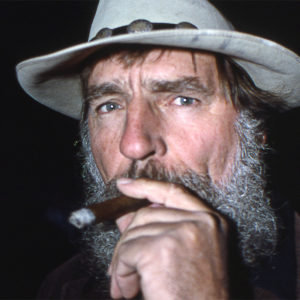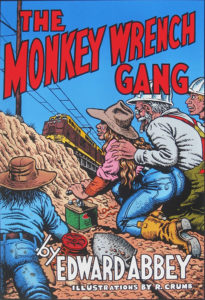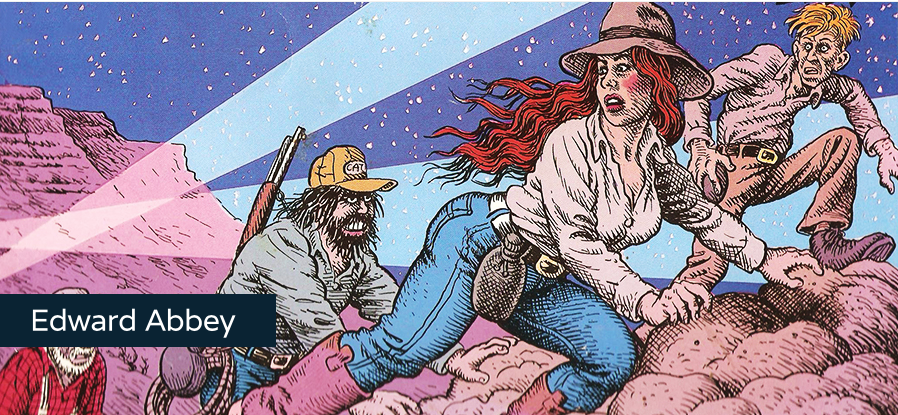My appreciation of Abbey was published in American Rebels (Nation Books, 2003) edited by Jack Newfield.
Edward Abbey (1927–1989) was the quintessential American: the Easterner who headed West, pulling up stakes and lighting out for the Territories, looking back over his shoulder only to make sure no one was following.
He was also the quintessential American writer: the maverick by design as well as temperament, scorning the establishment, courting fame while pretending to flee from it, hiding rather than flaunting his education and literary sophistication.
 Abbey wrote some twenty books, most of them collections of occasional essays, two of them immortal gems, but all with the same theme: the awesome beauty and ongoing rape of the last great American wilderness, the high desert of the Colorado Plateau. His greatest (if not his favorite) Desert Solitaire, is about nature’s power to save us from ourselves; and his most popular (if not his best), The Monkey Wrench Gang, is about our power to save nature from ourselves, or at least slow its desecration, provided we are willing to act the outlaw.
Abbey wrote some twenty books, most of them collections of occasional essays, two of them immortal gems, but all with the same theme: the awesome beauty and ongoing rape of the last great American wilderness, the high desert of the Colorado Plateau. His greatest (if not his favorite) Desert Solitaire, is about nature’s power to save us from ourselves; and his most popular (if not his best), The Monkey Wrench Gang, is about our power to save nature from ourselves, or at least slow its desecration, provided we are willing to act the outlaw.
Abbey loved the desert as only a kid from the green-robed East can love the naked Earth unclothed. His father, a part-time Appalachian trapper and logger, read him Whitman (“resist much; obey little”) and bragged of once shaking Big Bill Haywood’s hand. The poet and the Wobbly fit together perfectly in Ed. It was while riding the rails as a young man that he first encountered the wide open spaces of the West, where the cliché fit the reality like a key in a lock.
Arizona opened all his doors, and they stayed open. After a brief stint in the military (he left boot camp on V-J Day) Abbey took his G.I. Bill to the University of New Mexico in Albuquerque. He had already started writing, a discipline he honored faithfully until the day he died. He looked up novelist William Eastlake, and wedged himself into Wallace Stegner’s writing program, where he and Wendell Berry were classmates. There was never any question about his orientation: rebellion. He wore dark clothes and drank jug wine. Rexroth and Patchen were his beacons. He scrapped his first attempt at a novel, Down the Road, when Kerouac’s was published in 1956.
But Beat was only a temporary pose for Abbey. He had higher ambition than to be part of a school, even the most successful one since Bloomsbury. He wanted to be the headmaster, the teacher, the student and the dropout all in one.
Like Gary Snyder, another of the Beats whose accomplishments transcended even their overweening ambition, Abbey went to work as a Park Ranger. It was seasonal, solitary work that suited him perfectly. “Lazy scheming loafers,” he was later to call himself and his colleagues. “Put them to work.”
Abbey’s fame and influence rests on two singular works. The first of these, Desert Solitaire, a memoir of his time as a ranger at Arches Park, in southern Utah, immediately established him as a poetic and precise nature writer (a term he grew to hate); “the Thoreau of the West,” Larry McMurtry was to call him. Published in 1968, it alternated haunting evocations of the slickrock desert with sardonic reflections on man’s place in the universe: “I’m a humanist; I’d rather kill a man than a snake.” It put Edward Abbey on the map as an articulate rebel with a profane and profound sense of humor; and 1968, you will recall, was a good year for rebels.
Even this contemplative work was a call to action, decrying the National Park Service’s thralldom to corporate interests and exhorting readers to pick up a rock and “throw it at something big and glassy.” This was a theme Abbey was to develop in all his works, becoming more radical and more explicit as he went along.
By the time Desert Solitaire came out, Abbey had already written several novels, among them The Brave Cowboy, made into a film which Kirk Douglas considered his best. Lonely are the Brave (“Pompous is the Title,” Abbey once quipped), about a maverick cowboy who refuses to join the modern world, was Abbey’s last and only homage to the conventional hat-and-boot iconography of the Old West.
 The Brave Cowboy was a success, but it was Abbey’s third novel, The Monkey Wrench Gang, that made him famous. Published in 1975, it was inspired (as the saying goes) “by real events,” and it inspired and is still inspiring many more. Monkey-wrenching is sabotage. Adopted by radical environmentalists (primarily Earth First, which calls Abbey its patron saint) it was and is enormously effective, both in practical and PR terms. It’s a David-and-Goliath thing.
The Brave Cowboy was a success, but it was Abbey’s third novel, The Monkey Wrench Gang, that made him famous. Published in 1975, it was inspired (as the saying goes) “by real events,” and it inspired and is still inspiring many more. Monkey-wrenching is sabotage. Adopted by radical environmentalists (primarily Earth First, which calls Abbey its patron saint) it was and is enormously effective, both in practical and PR terms. It’s a David-and-Goliath thing.
In the novel, a small group of dedicated misfits (a macho ex-Green Beret, a Mormon rancher, a droll M.D. fond of classical music and dynamite and, of course, a pretty girl) drive bulldozers off cliffs, pull up survey stakes, cut power lines, trash billboards, and generally act in an exemplary manner to preserve the West from those who would “develop” it. It’s a how-to book: how to place charges, where to get explosives, which goo to pour into carburetors (Karo syrup is good); it’s an environmentalist’s manual of arms, detailing security measures and secret signals, tools and procedures for a guerrilla war against corporate greed and arrogance. People have tried it, and it works. This is the kind of reader response that Abbey sought and treasured.
In one of the innumerable websites dedicated to Abbey, an unnamed comrade tells how the writer was too “technologically challenged” in real life to hot-wire a bulldozer. No matter. His fictional hero, George Washington Hayduke, is the hot-wirer from Hell. Abbey was always quick to admit that he lacked the skill and courage of his heroes. He even once claimed it was all made up for laughs.
The claim itself brought laughs.
The Monkey Wrench Gang is dedicated to Ned Ludd, but Abbey had bigger targets in mind than mere machines. The fictional (and real) target of this exemplary novel is the Glen Canyon Dam, which turned one of the world’s wonders into a playground for JetSkis and a power source for the lights of Las Vegas. The ultimate aim of the Monkey Wrench Gang and, indeed, of the book itself, is to bring down the dam. Abbey’s hatred for this monumental environmental crime was very personaL He was among the last to make the trip first made by John Wesley Powell in the 1870s.
Hayduke, the hard drinking ecoterrorist, is Abbey’s second-greatest fictional creation; the first was himself. He cultivated the image of the hard-drinking literary redneck. He had a network of like-minded friends, a resentful circle of ex-wives, and a legion of enemies among the mining corporations, the cattle companies, the developers and despoilers of the West. Professional environmentalists hated him, too; he called the Sierra Club the Sahara Club and never forgave their role in making possible the inundation of Glen Canyon.
Enemies suited Abbey. He loved a fight, which meant that he could stay in the wilderness for only so long. The notoriety brought by The Monkey Wrench Gang, together with the literary respectability of Desert Solitaire, combined to provide him a bully pulpit, which he used to spout off on feminism (bad), mountain lions (good), immigration (give ‘em a rifle md send ‘em home), cowboys (peasants on horseback), and the National Parks (rip out the roads). He was politically correct only about his one big issue, but that was enough.
And always his reputation grew, like a weed. Abbey was successful as only a handful of American writers have been, winning the admiration of his peers, the love and respect of his readers, and the grudging recognition of the establishment. He was as leery of that as a coyote eyeing a trap. Offered a prize by the American Academy of Arts and Letters, he turned it down, claiming he had a river to run.
“At least I won’t have to floss anymore,” he said, when told he was dying. He was barely in his sixties. He wanted to croak in the desert under the stars, but dying is as hard as living, and his friends finally hauled him back indoors where he died under the black peasant’s sabot on his wall. Then they buried him in a still-undisclosed location, where his friends are said to gather for a few beers every year on his birthday. His name still sends a shudder through all those who would build a new ski resort, poison a coyote, or carve a road into a canyon wilderness.
Do a web search and tell me Edward Paul Abbey is no longer around. Hell, there’s even an Ed Abbey refrigerator magnet, available online. He would have liked that. The refrigerator was one of the few machines he genuinely admired, because it kept his beer cold.
Was he serious? Did he really mean that those who loved the wilderness should break the law to save it? Did he really believe that the laws of nature are more sacred than the laws of man?
Yes.
Edward Abbey was for pulling up stakes, literally and explicitly: “Always remove and destroy survey stakes, flagging, advertising signboards … and other such artifacts of industrialism. “
The legacy of Edward Abbey is the triumph of literature. He stole the title of one of his last books from his own readers’ graffiti. Hayduke Lives! is more than a threat, more than a warning. It’s a promise that sooner or later, the dam will come down.
(Thanks for your interest in my work. If you enjoyed this little piece, please give a dollar to a homeless person.)

